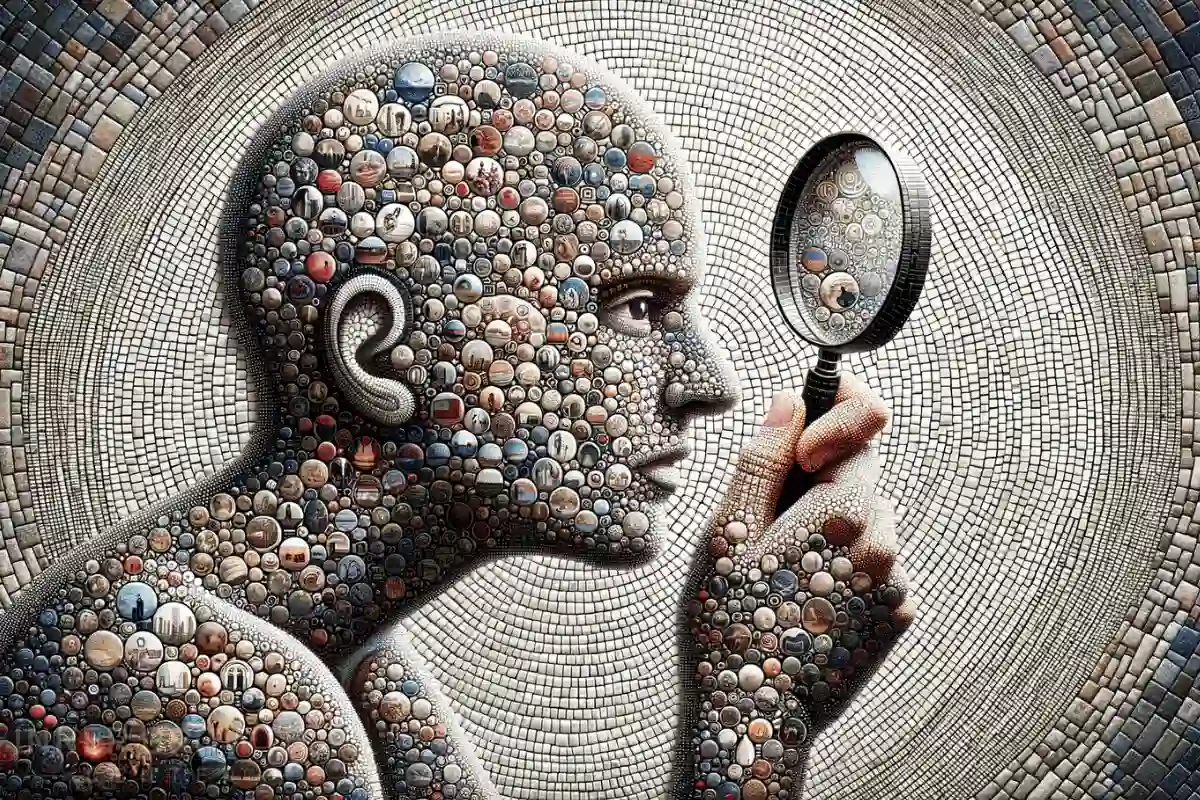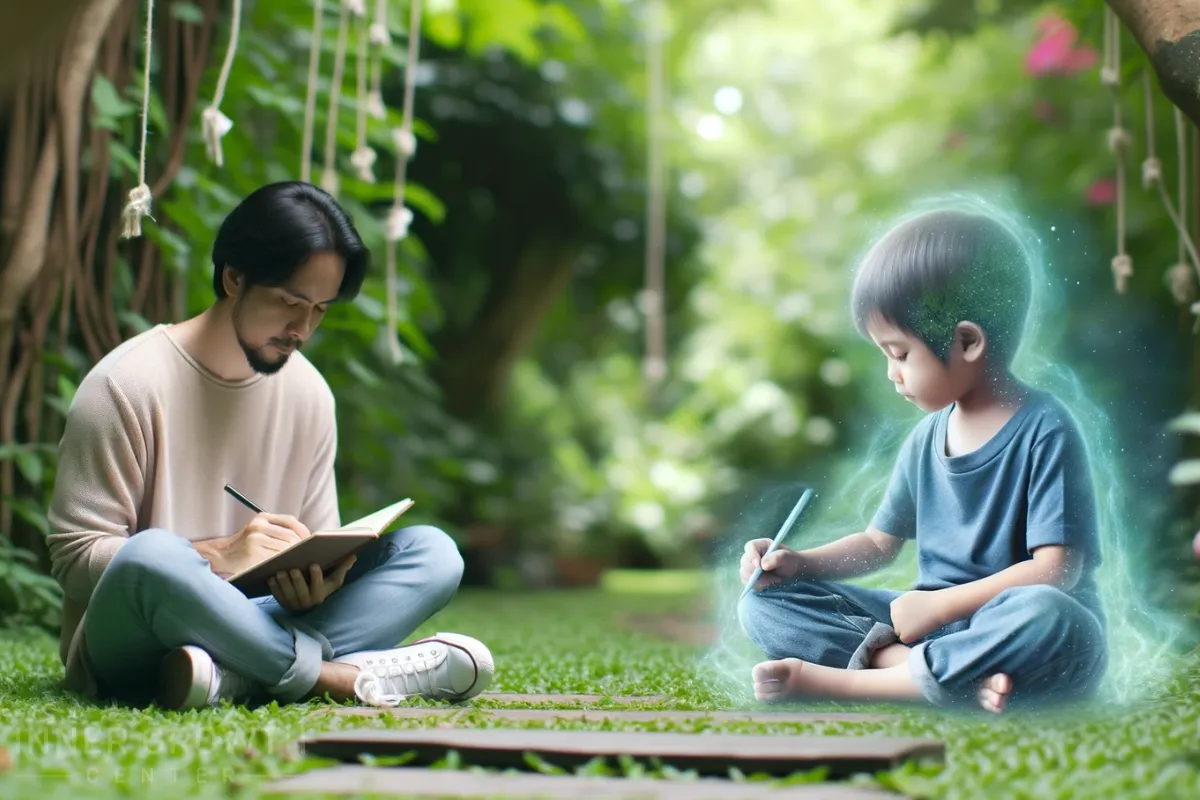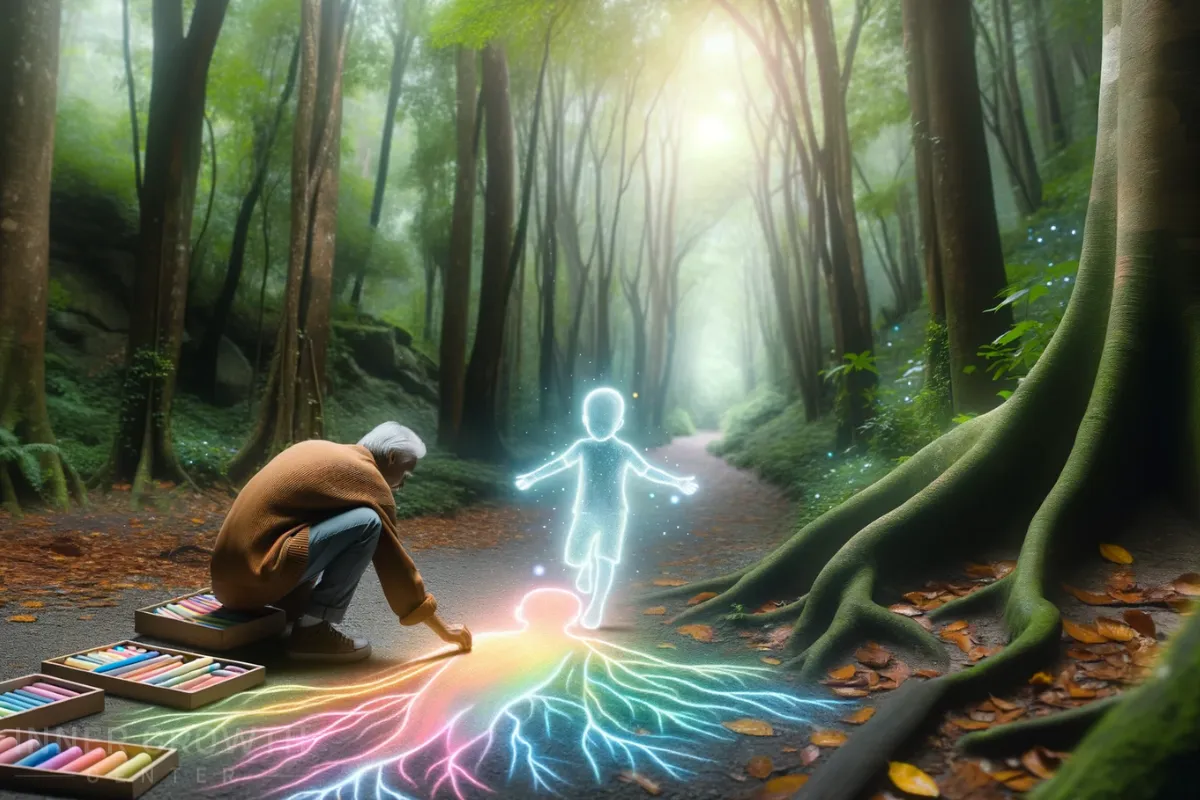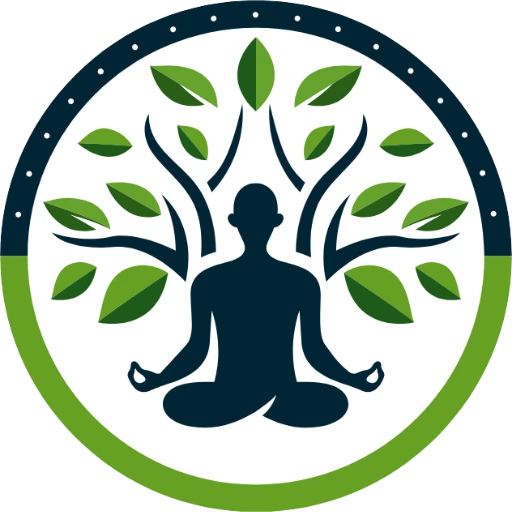Have you ever felt a pang of nostalgia so strong it seemed to pull at your very soul, or found yourself overreacting in a way that felt strangely childlike?
Perhaps there’s a song that takes you back to a moment of pure joy or a scent that stirs a long-forgotten sadness.
These are whispers from your inner child, the part of you that remembers every joy and pain, every hope and fear.
Why do these moments of childhood call back to us with such clarity and emotion?
It’s because our inner child holds the key to the vault of our emotional heritage – locking away our most moving moments of vulnerability and authenticity.
Inner child healing can be seen as opening your vault, understanding its contents, and integrating them into our adult lives.
This process is about rediscovering the unbounded creativity and innate curiosity of our younger selves, and letting those qualities infuse our adult lives with greater authenticity and joy.
So, how do we begin this journey of reconnection and healing? How do we address the echoes of laughter and cries that seem to shape so much of who we are today?
Let’s explore how embracing and healing your inner child can lead to deep shifts in your everyday life.
Understanding the Inner Child

The concept of the “inner child” is a compelling theory in the field of psychology, highlighting the deep-seated, early-life influences that shape our adult behaviors and emotional health.
It represents a part of our subconscious that retains the capacity to experience innocence, wonder, and trauma from the stages of our childhood.
Recognizing and nurturing this aspect of the self can lead to profound healing and personal growth.
Origins of Inner Child Theory
The theory of the inner child has its roots in the work of renowned psychoanalyst Carl Jung, who referred to it as the “divine child” and associated it with the deeper, untouched part of the psyche that signifies our true self.
Over the decades, psychologists and therapists have expanded on Jung’s concepts, discussing the inner child as the source of a person’s emotional health and vitality.
This part of our psyche holds not only our capacity for joy and discovery but also the scars of our earliest wounds.
Common Signs of a Wounded Inner Child
Identifying a wounded inner child helps in understanding various adult issues, particularly those related to emotional and relationship stability. Common signs include:
- Difficulty with emotional regulation: Unexplained outbursts of anger, sudden sadness, or overwhelming fear.
- Fear of abandonment: Persistent worry that loved ones will leave, leading to clingy or dependent behavior in relationships.
- Challenges with trust: Difficulty trusting others or constant fear of betrayal.
- Low self-esteem: Persistent feelings of inadequacy or unworthiness that don’t seem to be linked to current life events.
- Recurring patterns in relationships: Repeatedly forming relationships with individuals who may abuse, neglect, or take advantage of them.
Psychological Impacts of Neglecting Inner Child Issues
Ignoring the needs and wounds of the inner child can lead to a variety of long-term psychological consequences. Adults might experience:
- Persistent anxiety and depression: Ongoing emotional turmoil that doesn’t fully respond to typical treatments or that seems disproportionate to one’s current life circumstances.
- Addictive behaviors: Turning to substances, compulsive eating, or other destructive behaviors as a way to self-soothe or escape pain.
- Sabotaging success: Subconsciously undermining personal or professional opportunities because of an underlying belief of not being good enough.
- Social withdrawal or isolation: Avoiding social interactions to protect oneself from potential rejection or hurt.
Understanding the inner child not only involves recognizing these symptoms and their origins but also taking proactive steps toward healing.
What is Inner Child Healing?

Inner child healing is a therapeutic process aimed at addressing and resolving the emotional and psychological wounds of one’s childhood.
This form of healing focuses on reconnecting with the often neglected or hurt part of ourselves—the inner child—that still lives within us as adults.
The goal is to acknowledge, understand, and heal the origins of adult issues rooted in childhood experiences.
Core Principles of Inner Child Healing
- Acknowledgment: Recognizing that a vulnerable, childlike part of oneself has been ignored or wounded and needs attention and care.
- Compassion: Approaching one’s inner child with kindness, gentleness, and understanding, rather than judgment or criticism.
- Reparenting: Providing oneself with the love, security, and boundaries that one may not have received sufficiently during childhood.
- Integration: Harmonizing the inner child with the adult self, leading to a more cohesive and authentic identity.
Through various techniques, such as therapy, creative expression, and introspective practices, inner child healing allows individuals to revisit and heal their childhood selves, leading to profound transformations in their adult lives.
This healing offers a pathway to release past traumas, confront deep-seated fears, and reclaim the joy and innocence that were compromised or lost.
Causes of Inner Child Wounds

Understanding the root causes of inner child wounds can help for more effective healing. These wounds can stem from a variety of experiences during childhood, many of which disrupt the child’s development and emotional growth. Here are some of the most common causes:
Types of Experiences that Wound the Inner Child
- Trauma: Experiences such as accidents, natural disasters, loss of a loved one, or witnessing violence can deeply impact a child’s emotional well-being.
- Neglect: Emotional neglect, where a child’s emotional needs are consistently ignored or minimized, can lead to feelings of abandonment and low self-worth.
- Abuse: This includes physical, sexual, and emotional abuse. The trauma from abuse can result in a wide range of emotional and behavioral issues in adulthood.
- Parental Issues: Parents’ own unresolved emotional issues, mental health struggles, or substance abuse can prevent them from providing the stable, nurturing environment essential for a child’s growth.
Role of Family Dynamics and Environment
- Dysfunctional Family Dynamics: Patterns of dysfunction such as excessive criticism, lack of privacy, unpredictability, or constant conflict can create a stressful environment for a child.
- Overprotection: While less obvious, an overprotective environment can also harm a child’s development by not allowing them to experience normal risks and challenges, which can stifle growth and foster dependence.
- High Expectations: Excessive pressure to perform academically, in sports, or in other areas can lead to anxiety and an overwhelming fear of failure.
Manifestation in Adult Behaviors and Relationships
- Reenactment of Childhood Dynamics: Adults may find themselves repeating or attracting relationships that mirror the dynamics they experienced in childhood, even if those patterns are unhealthy.
- Emotional Instability: Wounded inner children can manifest as mood swings, anger, depression, or anxiety in adulthood.
- Self-Sabotage: Subconscious fears and beliefs, rooted in childhood experiences, can lead adults to sabotage their own success or relationships.
Recognizing these causes is the first step in addressing and healing the wounds of the inner child.
By understanding the origins of these emotional injuries, individuals can better navigate the path to recovery and healing.
Techniques for Inner Child Healing

Healing the inner child involves a blend of professional therapeutic techniques and self-help strategies that foster deep, transformative changes.
Here are some of the most effective methods used to heal the inner child:
Psychotherapy Approaches
- Cognitive-Behavioral Therapy (CBT): Helps individuals recognize and change negative thought patterns and behaviors associated with their inner child wounds. CBT can be particularly effective in addressing irrational fears and self-destructive behaviors that stem from early childhood experiences.
- Psychodynamic Therapy: Focuses on exploring the unconscious mind and its influence on current behavior. This approach helps uncover deep-rooted feelings and unresolved conflicts from childhood, facilitating a deeper understanding and healing.
- Eye Movement Desensitization and Reprocessing (EMDR): Originally designed to treat PTSD, EMDR has been effective in addressing emotional distress linked to traumatic childhood events by helping patients process these experiences in a safe and controlled environment.
Creative Therapies
- Art Therapy: Provides a non-verbal outlet for emotions and thoughts, making it easier for individuals to express and understand their inner child’s needs and experiences.
- Music Therapy: Uses music to help individuals access and express feelings that may be hard to communicate otherwise. It can be a powerful way to connect with one’s inner child and soothe emotional wounds.
Self-help Strategies
- Journaling: Writing about childhood experiences or directly to one’s inner child can help in acknowledging and processing those deep-seated emotions.
- Mindfulness and Meditation: These practices help cultivate a state of awareness and presence that can alleviate the impact of past traumas and promote emotional healing.
- Inner Child Workshops and Retreats: Participating in these focused sessions can provide structured guidance and community support, which are often crucial in healing journeys.
Steps to Start the Healing Process
Starting the journey of inner child healing can be challenging, yet it is deeply rewarding. Here are some steps to begin this transformative process:
- Recognition and Acknowledgment
- Identify behaviors or patterns that may stem from childhood experiences.
- Acknowledge the presence and needs of your inner child, understanding that this part of you requires attention and care.
- Establishing a Dialogue
- Start a “conversation” with your inner child through meditation or journaling. Ask what they need, how they feel, and what you can do to help them.
- Validate their feelings and experiences, regardless of how minor they might seem from an adult perspective.
- Providing What Was Missing
- Offer your inner child what they lacked in the past – be it safety, love, validation, or boundaries.
- Engage in activities that you enjoyed as a child or would have liked to experience, such as playing a beloved game, exploring nature, or learning a new skill purely for fun.
- Re-parenting Yourself
- Practice self-care and self-compassion. Treat yourself as you would a cherished child, with kindness, patience, and understanding.
- Set healthy boundaries in your relationships and daily life to protect and nurture your inner child.
- Professional Guidance
- Consider seeking support from a therapist who specializes in inner child work. They can provide the tools and space needed to heal deeply ingrained wounds.
Through these steps, individuals can begin to heal their inner child, leading to greater emotional freedom and a more authentic life.
This journey helps not only in resolving past traumas but also in cultivating a fulfilling present and a hopeful future.
Challenges in Healing the Inner Child
Healing the inner child is a deeply personal and often challenging journey that can vary significantly from one person to another. Recognizing and overcoming these challenges is crucial for effective healing and long-term growth.
Common Setbacks and Overcoming Them
- Resistance to Facing Pain: Delving into childhood memories can be painful and frightening. This natural resistance can manifest as denial, minimization, or avoidance. Overcoming this requires patience, self-compassion, and sometimes the support of a skilled therapist.
- Emotional Overwhelm: The process can sometimes unlock intense emotions that were suppressed for years. Managing this overwhelm might require adjusting the pace of therapy and employing grounding techniques like mindfulness or focused breathing.
- Relapse into Old Patterns: Healing is rarely linear. There may be times when one falls back into old habits or emotional responses. Recognizing these as part of the healing journey and not signs of failure is key.
Importance of Patience and Perseverance
- Healing the inner child takes time and effort. It requires an ongoing commitment and the understanding that setbacks are part of the healing process, not the end of it.
Seeking Professional Help
- While many aspects of inner child healing can be managed with self-help strategies, professional guidance can be invaluable, especially when dealing with deep-seated trauma or when progress seems to stall.
Embracing Your Inner Child
Embracing your inner child is an act of deep personal kindness and a crucial step in the journey of self-healing.
It involves recognizing that within each of us resides a childlike essence that holds the keys to our unfiltered emotions and primal needs.
This acknowledgment paves the way for a nurturing connection, fostering a safe space where healing begins.
Healing does not mean erasing the past.
Instead, it signifies understanding and integrating these early experiences into your life’s narrative in a way that fosters growth and self-acceptance.
As you embrace your inner child, you might discover a wellspring of creativity and joy that has been muted over the years.
Reconnecting with this part of yourself can be transformative, allowing you to experience the world with renewed wonder and enthusiasm.
This reconnection allows you to feel and heal from the pains that were once too difficult to handle.
Remember, this process is not a race.
Each small step towards understanding and accepting your inner child is a leap towards a more wholehearted and fulfilling existence.
Through embracing your inner child, you allow your entire being to move forward with greater harmony and less internal conflict.
This reconciliation is the essence of true healing – creating a peaceful coexistence within oneself that radiates outward into every aspect of life.



